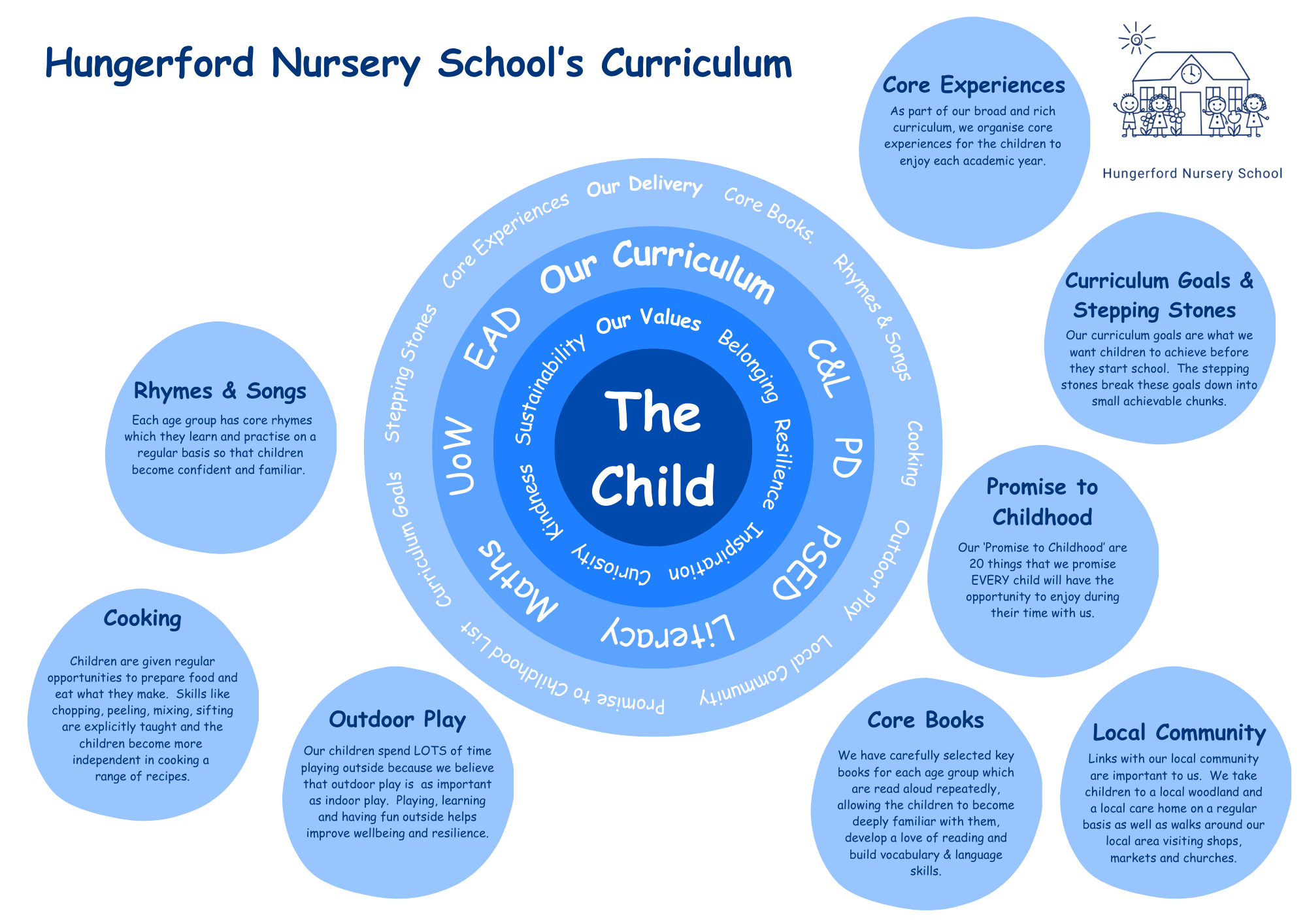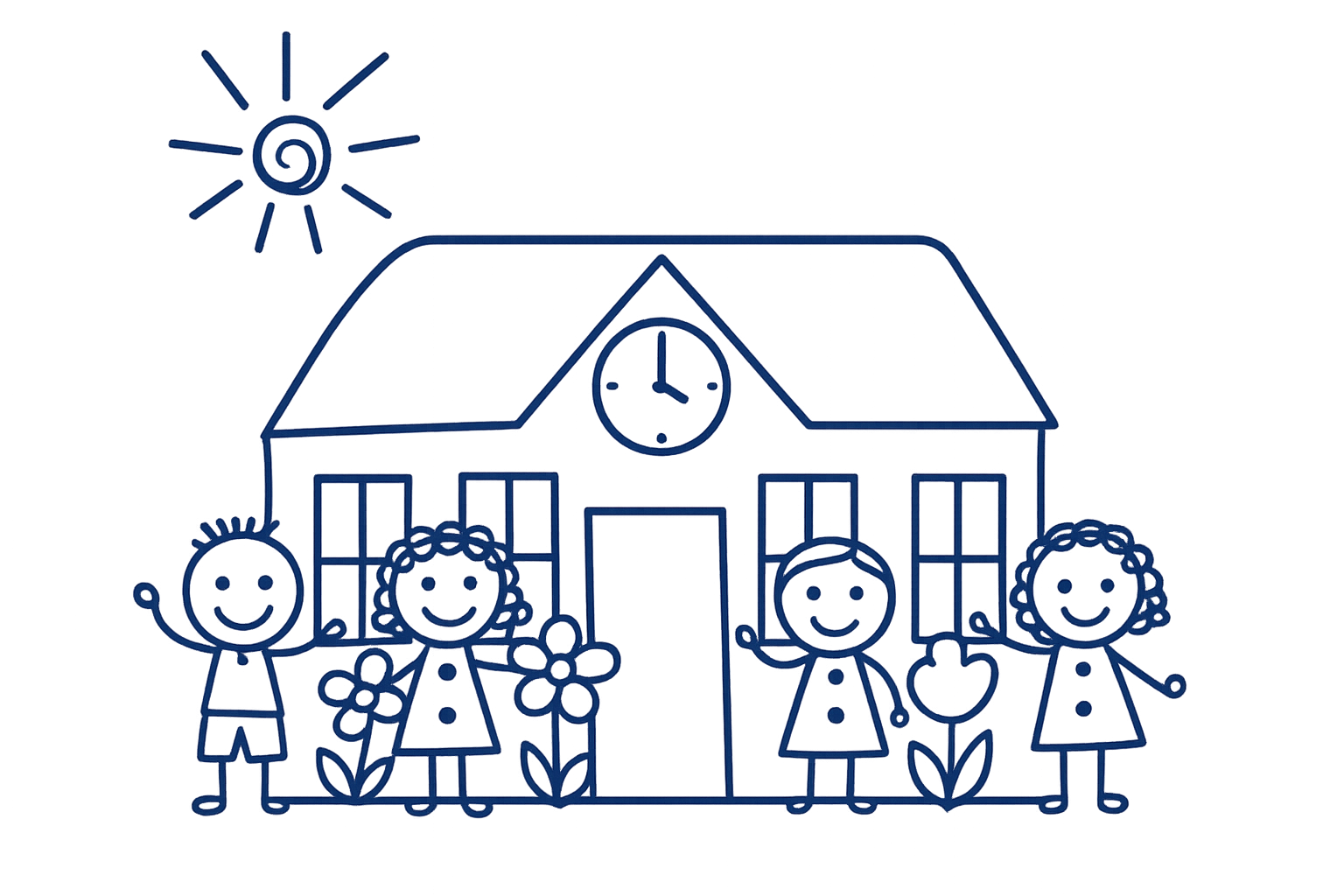Curriculum

Our curriculum map (above) has been carefully designed with our children at the heart, ensuring every experience and opportunity supports their unique needs, interests, and developmental journey.
The EYFS Framework (July 2025) sets out the seven key areas of learning and development for children in the Early Years Foundation Stage. Click on each area below to read about our intent for each area as well as what you might see in everyday practice in our nursery school that supports each area (implementation).
Prime Areas of Learning
Communication and Language (C&L)
Intent
We aim to support all our children to become effective communicators; to be able to listen, receive and process information and ideas and to be capable of expressing their thoughts and feelings in a meaningful way to others. We believe well-developed communication and language skills will provide a firm foundation for children’s overall development. We strongly believe in developing attention and listening skills, and stimulating a love of words and extending vocabulary. We also believe and recognise the importance of developing our children’s love of reading by sharing with them a wide range of texts and by teaching them early phonic skills that will support their reading development.
Implementation
- Daily routines reassure and help children understand the structure of the day and predict what is coming next.
- Visual prompts to support children who are unable to understand verbal prompts.
- Resources organised to promote independence and choice.
- High quality interactions between the adults and the children to model, support and extend childrens' communication and language.
- Well-planned group times to enable story and singing opportunities as well as teaching of specific skills.
- PECS to support children with SEND, in helping with their needs and wants being met.
- Opportunities to be outside to develop listening and attention skills and widen their exploration and understanding of the world around them.
- Bucket Time to develop listening and attention skills.
Physical Development (PD)
Intent
We recognise that physical development supports children in all that they experience. We ensure that we provide opportunities that require appropriate physical challenge, with adequate space both indoors and outside to set up their self-chosen learning opportunities. We ensure that all children participate in gross and fine motor activities, using a variety of equipment, to develop these skills. It is important that children are introduced to the language of movement when performing actions. We promote independent self-care at all times. We believe that children should be given opportunities to challenge themselves, as we know that strong physical skills can boost our self-esteem and confidence.
Implementation
- Daily routines for physical activity, snacks and self-care.
- Managing own belongings using drawers and bags.
- Resources organised to promote independence and choice.
- Adults modelling and supporting children to develop physical skills.
- Gross motor skills are developed through challenging climbing equipment in each outdoor space, as well as sandpits, water play, swings and bikes and scooters.
- Fine motor skills are developed through a range of opportunities such as sensory play, threading, tweezers, mark making, hammering etc…
- Visits to the woods and outdoor spaces allow children to develop their gross and fine motor skills in a less predictable environment.
- Cooking and food experiences to understand and explore healthy eating.
- Opportunities to use real tools such as scissors, knives, forks, spoons, hammers, saws etc... are regularly provided.
Personal, Social and Emotional Development (PSED)
Intent
Emotional well-being is vital: a child who is unhappy is not able to learn. Personal, Social and Emotional (PSE) is crucial in the building blocks for children’s overall development.
We support children to learn to get on with others and make friends, understand and talk about feelings, notice how others are feeling, learn about 'right' and 'wrong'. We teach children to say ‘stop’ if they do not like something that is happening, care for others, be able to ask for help. We develop independence skills, such as taking care of their belongings and finding resources. Ultimately, we want children to feel good about themselves and be resilient, bouncing back when things get tricky.
Implementation
- Daily routines reassure and help children understand the structure of the day and predict what is coming next.
- Visual prompts to support children who are unable to understand verbal prompts.
- Resources organised to promote independence and choice.
- Adults support and model to children, making correct decisions, practising self-regulation skills and conflict resolution.
- Group times focussed on building relationships to develop confidence and social skills.
- Opportunities for children to plan their learning and play and also reflect on their challenges and successes.
- Stories being used as a hook into a particular area of development, situation or behaviour need.
Specific Areas of Learning
Literacy (L)
Intent
We aim to encourage children to develop essential skills in listening, talking, reading and writing for learning, life and pleasure. We want them to be able to recount experiences and stories, including innovating stories with confidence. We wish to foster a love of reading through providing a rich environment which stimulates and encourages children’s reading. Our purpose is to motivate children to write by being curious and making marks that have meaning. Our ambition is that children are introduced to new vocabulary that can then be used.
Implementation
- We provide exciting and active learning environments that lay the foundations for the development of literacy skills.
- Adult-child interactions extends children's learning and enhances opportunities for sustained shared thinking.
- Questionning is used effectively to encourage children to share their ideas, explain their thinking and describe what they can see, hear, feel etc...
- Carefully selected books are available for children in the different areas of learning to enhance their learning.
- Cooking provides children with opportunities to follow simple recipes.
- We offer a wide range of mark-making resources for children to use and explore – pens, pencils, crayons, chalk, paint etc...
- Children are encouraged to recognise their name and other keywords.
- Our environment is rich in text and print appropriate to the children's age and stage.
- We use Write Dance to teach handwriting movements.
- We encourage parental involvement in developing their child's literacy development – regular books home to share, events such as World Book Day and Nursery Rhyme Week.
Phonics
- The teaching of phonics is an integral part of the curriculum in the EYFS. We use Letters and Sounds as the basis for our teaching of phonics. The children are guided through Phase One in preparation for their skills to be taken on further as they enter their Reception year. We use a range of multisensory strategies to enthuse and engage the children in their understanding of phonics, including the use of speaking and listening, songs, rhymes and practical games and activities.
- We offer parent workshops during the year to help parents understand and practise skills at home.
Mathematics (M)
Intent
We aim to ensure that children have access to a high-quality maths curriculum that is challenging, enjoyable and real. That they are provided with a variety of mathematical opportunities, which will enable them to make the connections in learning needed to enjoy greater depth in learning. We want to ensure that they can use manipulatives, such as their fingers and representations to engage with mathematical ideas.
Implementation
- We provide exciting, active learning environments that build strong foundations for the development of mathematical skills.
- We provide a range of stimulating resources and shape the learning environment to enhance real-life opportunities for developing skills in number, pattern, shape, space and measure.
- We make the most of the moments throughout the day, months, year and seasons to highlight and use mathematics, seizing opportunities to reinforce mathematical vocabulary.
- Adult/child interactions extend children’s learning and enhances sustained shared thinking and checks for any misconceptions.
- Questionning is used effectively to encourage children to share their ideas, explain their thinking and solve problems.
- Staff ensure there are appropriate resources at all times to challenge, stimulate and motivate children.
Understanding the World (UW)
Intent
We aim to ensure that we celebrate and recognise the important times in our children’s lives and their families. We offer enriched experiences of the wider world and celebrate diverse beliefs and values, promoting respect and tolerance of other cultures. Our purpose is to support children to explore the world around them, looking closely at the changes in the seasons, their local environment and beyond and in living things. We aspire to ‘Kindle their Curiosity’ to immerse the children in an environment that is enquiry-led by their interests and natural curiosity, where they solve problems, investigate, make decisions and experiment.
Implementation
- We follow children’s interests to make links in their learning and connections to the wider world.
- We provide exciting, active learning environments that build strong foundations for the development of understanding the world.
- Adult/child interactions extend children’s learning and enhances sustained shared thinking and checks for any misconceptions.
- Questionning is used effectively to encourage children to share their ideas and explain their thinking.
- Staff ensure there are appropriate resources at all times to challenge, stimulate, and offer provocation.
- Cooking experiences to understand changes and healthy food.
- Providing real-life experiences such as observing eggs hatching and minibeasts life cycles, growing plants, alongside exploring mud kitchens and going to the woods to understand the wider world around them.
- We ensure that within the environment there are examples of books from a range of occupations and cultures.
Expressive Arts and Design (EAD)
Intent
We aim to ensure that children are able to represent their ideas through a range of media. Our purpose is to stimulate children to explore and share their thoughts, ideas and feelings through a variety of art, design, technology, music, drama, movement, dance and imaginative play activities. We encourage children to paint, draw, collage, model using clay and other materials and use basic musical instruments. We help children to learn new songs and rhymes and enjoy singing them with each other. We encourage children's confidence to explore, and where they have to, solve problems, investigate, make decisions, design and experiment. At various times during the year, children are given the opportunity to participate in celebrations where they can use their singing and acting.
Implementation
- We follow children’s interests and support the exploration through resources and conversation. Offering an environment that is enquiry-led by their interests and natural curiosity.
- We provide engaging learning environments where children can explore a range of expressive arts and design, exploring a range of materials like clay, model making and woodwork.
- We provide a range of stimulating resources and shape the learning environment to enhance real-life opportunities for developing skills in being imaginative and exploring materials and media.
- Adult/child interactions are used to extend children’s learning and enhance sustained shared thinking.
- There are carefully selected and appropriate resources in relation to Expressive Arts and Design that challenge, provoke and stimulate their development. We provide a wide range, including a range of musical instruments, books, role-play items and dressing up, paint, resources that support children taking on a role etc...
